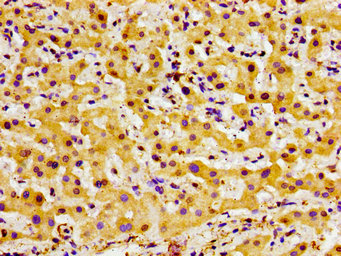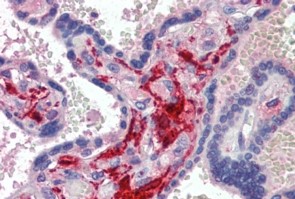![Factor XIIIa (Coagulation Factor XIIIA Chain)(F13A1/3772R), 0.2mg/mL [26628-22-8] Factor XIIIa (Coagulation Factor XIIIA Chain)(F13A1/3772R), 0.2mg/mL [26628-22-8]](https://biotium.com/wp-content/uploads/2021/02/view_image-416.jpeg)
Factor XIIIa (Coagulation Factor XIIIA Chain)(F13A1/3772R), 0.2mg/mL [26628-22-8]
BNUB3772
ApplicationsImmunoHistoChemistry, ImmunoHistoChemistry Paraffin
Product group Antibodies
TargetF13A1
Overview
- SupplierBiotium
- Product NameFactor XIIIa (Coagulation Factor XIIIA Chain)(F13A1/3772R), 0.2mg/mL
- Delivery Days Customer9
- ApplicationsImmunoHistoChemistry, ImmunoHistoChemistry Paraffin
- CertificationResearch Use Only
- ClonalityMonoclonal
- Clone IDF13A1/3772R
- Concentration0.2 mg/ml
- Gene ID2162
- Target nameF13A1
- Target descriptioncoagulation factor XIII A chain
- Target synonymsF13A, coagulation factor XIII A chain, FSF, A subunit, TGase, bA525O21.1 (coagulation factor XIII, A1 polypeptide), coagulation factor XIII, A polypeptide, coagulation factor XIII, A1 polypeptide, coagulation factor XIIIa, factor XIIIa, fibrin stabilizing factor, A subunit, fibrinoligase, protein-glutamine gamma-glutamyltransferase A chain, transglutaminase A chain, transglutaminase. plasma
- HostRabbit
- IsotypeIgG
- Protein IDP00488
- Protein NameCoagulation factor XIII A chain
- Scientific DescriptionRecognizes a protein of 83 kDa, which is identified as Factor XIIIa. It has been identified in platelets, megakaryocytes, and fibroblast-like mesenchymal or histiocytic cells in the placenta, uterus, and prostate, monocytes and macrophages and dermal dendritic cells. Anti-factor XIIIa has been found to be useful in differentiating between dermatofibroma (almost all cases are positive), dermatofibrosarcoma protuberans (-/ ) and desmoplastic malignant melanoma (-). Anti-factor XIIIa positivity is also seen in capillary hemagioblastoma, hemangioendothelioma, hemangiopericytoma, xanthogranuloma, xanthoma, hepatocellular carcinoma, glomus tumor, and meningioma. Primary antibodies are available purified, or with a selection of fluorescent CF® Dyes and other labels. CF® Dyes offer exceptional brightness and photostability. Note: Conjugates of blue fluorescent dyes like CF®405S and CF®405M are not recommended for detecting low abundance targets, because blue dyes have lower fluorescence and can give higher non-specific background than other dye colors.
- SourceAnimal
- Storage Instruction2°C to 8°C
- UNSPSC12352203





